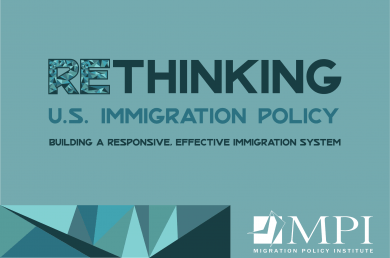Rethinking U.S. Immigration Policy: Building a Responsive, Effective Immigration System
|
|
| View Event Launching the Initiative |
This multiyear MPI initiative is generating a big-picture, evidence-driven vision of the role immigration can and should play in America’s future. Drawing from research, data analysis, and insights gained from convenings of key stakeholders across the spectrum, the Initiative is providing policy ideas and proposals—both administrative and legislative—that reflect new realities and needs for immigration to continue to be a comparative advantage for the United States as a society.
Among the key topics covered: The economic, labor market, and demographic impacts of immigration; immigration and national security; humanitarian, family-, and skills-based immigration; immigration enforcement; and immigrant integration.
Historically, across-the-aisle cooperation and consensus building have been essential for immigration policymaking and legislation to succeed. MPI is committed to re-energizing such bipartisanship in shaping and advancing feasible solutions for a system that is widely acknowledged as being broken.
Read the initiative Concept Note, Rethinking U.S. Immigration Policy: New Realities Call for New Answers.
Research prepared for the initiative includes:
A New Way Forward for Employment-Based Immigration: The Bridge Visa
U.S. employment-based visa policies, last updated in 1990, are not aligned with the country’s current and future labor market needs. This policy brief outlines MPI’s proposal for a new visa pathway that could help the United States better leverage immigration to meet its labor market needs, boost protections for both U.S.- and foreign-born workers, and flexibly adapt to future economic and demographic changes.
At the Breaking Point: Rethinking the U.S. Immigration Court System
With a backlog of nearly 2 million cases, years-long wait times for decisions, and overwhelmed judges whose productivity has declined, the U.S. immigration court system is in urgent need of repair. This report examines the factors that have driven the courts to crisis. It then outlines recommendations that promise to advance the goal of delivering timely and fair decisions, and to support the health of the U.S. immigration system more broadly.
Toward a Better Immigration System: Fixing Immigration Governance at the U.S. Department of Homeland Security
Nearly two decades since the Department of Homeland Security (DHS) was founded in 2003, U.S. immigration governance is buckling from breakdowns in performance across key immigration components and partner agencies. This report advances ideas for DHS to fix its governance to manage immigration as a system, focusing on challenges in mission and structure, intra-DHS and interdepartmental collaboration, funding, and institutional culture.
From Jailers to Case Managers: Redesigning the U.S. Immigration Detention System to Be Effective and Fair
The U.S. immigration detention system is sprawling, expensive, and has long been criticized for its prisonlike conditions and health risks. The pandemic has brought these risks into even sharper focus. This report examines detention’s role in the U.S. immigration enforcement system and proposes a different approach centered on release with supervision and case management—tools that are less costly, more humane, and ensure compliance with immigration proceedings.
Rethinking the U.S. Legal Immigration System: A Policy Road Map
The U.S. legal immigration system, last significantly updated by Congress in 1990, is profoundly misaligned with demographic and other realities—resulting in enormous consequences for the country and for its economy. This road map sketches the broad contours of some of the most needed reforms in the legal immigration system, made all the more urgent by U.S. population aging and changing labor market demands.
Back on the Table: U.S. Legalization and the Unauthorized Immigrant Groups that Could Factor in the Debate
With legalization of the U.S. unauthorized immigrant population back on the table, this report offers estimates and characteristics for subgroups that have particularly strong equities, including DREAMers, Temporary Protected Status (TPS) recipients, and parents and spouses of U.S. citizens. It also traces past legalizations and details the range and scope of legalization options that policymakers have.
Obscure but Powerful: Shaping U.S. Immigration Policy through Attorney General Referral and Review
Among the many executive action tools the Trump administration used to significantly rewrite U.S. immigration policy is an obscure but powerful legal authority known as the attorney general’s referral and review. This report examines how this power’s use and impact have changed over time, deep-rooted concerns about it that predate the Trump administration but that have grown due to its more frequent use, and ways to improve it going forward.
Building a New Regional Migration System: Redefining U.S. Cooperation with Mexico and Central America
Addressing regional cooperation around migration will be among the immigration challenges and opportunities facing the incoming Biden administration. This report examines how movement between the United States, Mexico, and Central America has evolved in recent decades, and lays out a four-part strategy to expand opportunities for legal migration, address humanitarian protection needs, improve enforcement, and mitigate some of the forces driving people to emigrate.
At the Starting Gate: The Incoming Biden Administration’s Immigration Plans
Joe Biden pledged during his campaign to reverse some of the most restrictive immigration actions undertaken during Donald Trump’s four years in office. While some actions can be undone with the stroke of a pen, others will take more time. This policy brief outlines the incoming administration’s top immigration priorities, examines challenges and opportunities ahead, and previews MPI policy ideas that could improve the immigration system and advance the national interest.
Rethinking the U.S.-Mexico Border Immigration Enforcement System: A Policy Road Map
Consistent with its world view of immigration as threat, the Trump administration has shut down meaningful access to asylum at the U.S.-Mexico border, expelled more than 205,000 arrivals during the pandemic, and constructed hundreds of miles of border barriers. Yet these strategies cannot succeed over the long term, given realities. This road map sketches what an effective border management system would look like.
Navigating the Future of Work: The Role of Immigrant-Origin Workers in the Changing U.S. Economy
Immigrants and their U.S.-born children are key drivers of U.S. labor force growth. As some occupations grow and others decline, this report explores how these immigrant-origin workers fit within the changing world of work. It examines the degree to which these and other workers, from different racial/ethnic groups, hold growing and declining jobs, and what changes in the mix of jobs in the U.S. economy mean for workforce development and immigration policy.
Immigration and U.S. National Security: The State of Play Since 9/11
The U.S. government has made important progress in shoring up weaknesses at the nexus of immigration and national security since September 11, 2001. But as new threats emerge and evolve—including public-health emergencies such as the COVID-19 pandemic—the question is whether the post-9/11 system is up to the task of meeting these challenges, as this report explores.
How Does Immigration Fit into the Future of the U.S. Labor Market?
The U.S. economy is facing an uncertain future as an aging workforce, stagnating labor force participation, skill mismatches, and automation reshape the labor market. This issue brief explores these forces and the role that immigration could play in supporting future U.S. economic growth. It also examines how immigration affects workers already in the country, both native born and immigrant.
Immigration and the U.S. Labor Market: A Look Ahead
In the coming decades, the U.S. labor market will undergo major transformation. This think piece, by a former chief economist for the U.S. Labor Department, explores how immigrant workers fit into this changing landscape, and what immigration and workforce policy changes could help maximize their contributions to the U.S. economy.
From Control to Crisis: Changing Trends and Policies Reshaping U.S.-Mexico Border Enforcement
How did the U.S. border enforcement picture go in the span of two years from the lowest levels of illegal immigration since 1971 to a spiraling border security and humanitarian crisis? This report draws on enforcement and other data as well as analysis of changing migration trends and policies to tell this story. The authors outline key elements for a new strategy that can succeed over the long term.
The U.S. Asylum System in Crisis: Charting a Way Forward
The United States has a long tradition of providing asylum to those in need. But in recent years, case backlogs have grown and many asylum seekers now wait years for a decision. This report examines the factors that have brought the U.S. asylum system to this crisis point and proposes common-sense steps that can be taken to restore timeliness and fairness, while deterring abuses.



